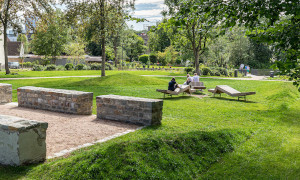The bdla Planting Planner Days took place for the first time on 17 and 18 February 2017, at the Schafhof in Freising. The location was appropriately chosen, as it was a model estate with a fruit tree nursery from 1819/20, which was to establish exemplary farming methods in the region.
The new training event of the professional association met with great interest: More than 300 interested people came to the Schafhof, Europäisches Künstlerhaus Oberbayern, and discussed the topic of "plants" - an essential field for landscape architects, as Irene Burkhardt, Vice President of the bdla, pointed out; especially after decades of landscape architectural orientation - in teaching and professional practice alike - towards clear and plant-poor public spaces. But: "The use of plants is gaining space again. Plant planning is becoming increasingly important in cities and communities", stated Swantje Duthweiler, Professor of Plant Use at the Weihenstephan-Triesdorf University of Applied Sciences (pictured).
Planning and conception of the 1st bdla Plant Planner Days were, so to speak, Swantje Duthweiler's first official act; the bdla spokesperson for plant use had been elected to the newly created office in April 2016. The professional association also underlines the stronger attention to plants and the importance of sustainable planting concepts by awarding a prize for high-quality plant use in the competition for the German Landscape Architecture Prize 2017.
The topics of the two-day event ranged from the climate effectiveness of plants and the effects of climate change on plants, to tendering, planting, acceptance and maintenance, to creative plant concepts in landscape architecture.
Teresa Zölch from the Technical University of Munich spoke about the ecosystem services of green infrastructure. The university's research project proved that trees play a significant role in reducing heat in the city. But which tree species are particularly suitable? Trees in the city are exposed to stress that is exacerbated by heat and weather extremes. And they are also subject to diseases that are introduced, which stress allows to spread, as Dirk Dujesiefken, professor at the Institute for Tree Care in Hamburg, explained. If you rely on just a few urban tree species, you run the risk of them failing. "There is no such thing as the tree for the future," Dujesiefken said. The point, he said, is to plant diversity and prevent drought stress. Above all, that means "less sealing, less groundwater drawdown and less soil compaction." And: choosing the right species for the particular location. This is where landscape architects will face a new challenge starting in 2020, because that's when the revamped permitting requirements from the 2009 Federal Conservation Amendment, for which there was a transitional rule, will go into effect. As of March 1, 2020, only native woody plants may then be planted in the wild. Christoph Dirksen from the Wilhelm Ley nursery explained what this means in practice and what challenges it poses for nurseries.
The largest part of the discussion on perennials was devoted to care. Sophisticated concepts, such as those presented by Lars Ruge from Vogt Landschaftsarchitekten AG, Susanne Füge from Hager Partner AG and Lorenz Dexler from TOPOTEK1, are doomed to failure after a very short time without proper care. Planning must be coordinated with the care budgets of the cities. Ralf Semmler from Datenbankgesellschaft mbH gave some suggestions as to how the maintenance costs of a plant could already be taken into account in the design. He presented how, with the help of a database, he can calculate the life cycle costs of coverings, plantings and furnishings as early as the preliminary design stage and make them more and more precise right up to the implementation planning stage. The subject of discussion on the second day was acceptance, completion, development and maintenance care. And Hans Gageler, member of the Rules and Regulations Committee Open Space Management of the FLL, presented the Image Quality Catalogue Open Spaces and the corresponding Signature Catalogue. In this catalogue, maintenance plans and tenders are explained with pictures and thus quality levels are defined in a generally understandable way; an aid for the communication of all parties involved about care and maintenance goals and their execution quality.
At the end of the event, Prof. Swantje Duthweiler held out the prospect of a continuation of the format and also immediately gave an outlook on a possible range of topics: rainwater infiltration - an area for which Copenhagen stands like no other city.
The 1st bdla-Pflanzplanertage took place in cooperation with the Bund Deutscher Baumschulen e.V. (BdB). (BdB) and were sponsored by DATAflor AG and the company Runge.
Association of German Landscape Architects bdla
Köpenicker Straße 48/49, 10179 Berlin
Tel. 030 27 87 15-0, Fax 030 27 87 15-55
- Latitude: 0
- Longitude: 0


